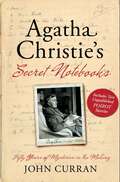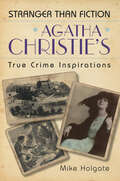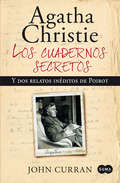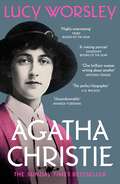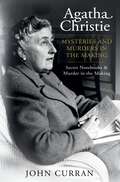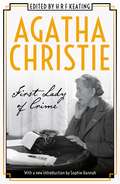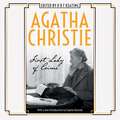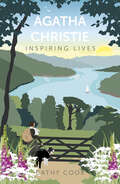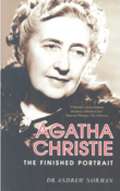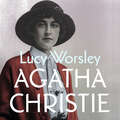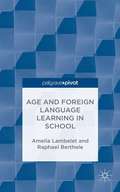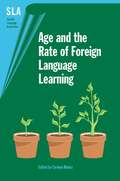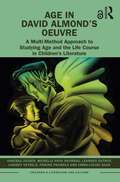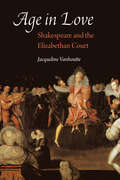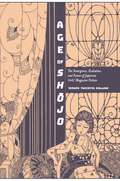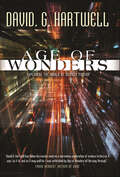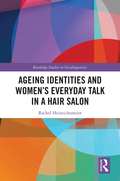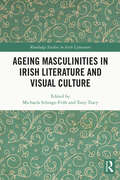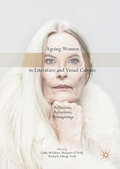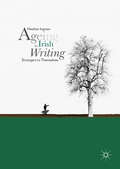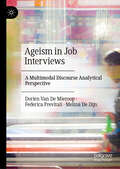- Table View
- List View
Agatha Christie's Secret Notebooks: Fifty Years of Mysteries in the Making
by John CurranAgatha Christie’s Secret Notebooks is the fascinating exploration of the contents of Agatha Christie’s long hidden notebooks, including illustrations, analyses, and two previously unpublished Hercule Poirot short stories. Not only will Christie’s legions of ardent fans find a treasure chest of new material from the author of such classics as And Then There Were None, Murder on the Orient Express, and Death on the Nile, but Agatha Christie’s Secret Notebooks is also a must-read tutorial for writers who want to learn the intricacies of constructing crime novels.
Agatha Christie's True Crime Inspirations: Stranger Than Fiction
by Mike HolgateFact proves far stranger than fiction in this collection of real-life crimes, scandals, tragedies and murders which either influenced the works of the world's most popular mystery writer or affected the lives of many famous personalities involved in her long and brilliant career. Discover the truth behind many of her books, such as how the exploits of Jack the Ripper inspired the serial killings in The ABC Murders and how the plot twist in The Murder of Roger Ackroyd was suggested by Lord Mountbatten. This book also reveals how many of her illustrious acquaintances found themselves immersed in episodes so bizarre that they could have been written by Christie herself, including how the father of Miss Marple actress Margaret Rutherford committed murder and Poirot actor Peter Ustinov witnessed the assassination of a world leader. Agatha Christie's True Crime Inspirations is a fascinating addition to Christie literature, focusing on little-known parts of this iconic writer's life and career. From her early roots in Torquay to her infamous eleven-day disappearance, no stone is left unturned as the events of her own life are revealed to be every bit as intriguing as her world-renowned novels.
Agatha Christie. Los cuadernos secretos
by John CurranUna fascinante exploración del contenido de los 73 cuadernos de notas de Agatha Christie recientemente descubiertos, que incluyen ilustraciones, extractos eliminados y dos novelas inéditas de Poirot. Cuando Agatha Christie falleció en 1976 se había convertido en la escritora más popular del mundo. Con unas ventas billonarias en todo el mundo y publicada en más de 100 países, había conseguido lo imposible: publicar más de un libro al año desde la década de 1920, y todos ellos éxitos de ventas. Tras la muerte de la hija de Agatha, Rosalind, a finales de 2004, se reveló un extraordinario legado. Entre sus objetos personales de la residencia familiar de Greenway se desenterraron los cuadernos privados de Agatha Christie, 73 volúmenes escritos a mano que habían permanecido en gran parte ignorados, probablemente debido a que la inconfundible caligrafía de Agatha era muy dificultosa de leer. Pero cuando el archivero John Curran comenzó a descifrar los cuadernos, se hizo evidente la magnitud de este tesoro escondido... Este libro abre la tapa del mayor secreto de Agatha Christie: cómo sus anotaciones, listados y borradores se convirtieron en los exitosos libros, obras de teatro y relatos que finalmente fueron. Argumentos alternativos, escenas eliminadas, incluso sus planes para libros que no llegó a escribir, la investigación de Curran revela una enorme riqueza de material inédito, incluidas dos novelas cortas de Hércules Poirot.
Agatha Christie. Los planes del crimen: Y un relato inédito de la señorita Marple
by John CurranLa vida y la obra de Agatha Christie a lo largo de las décadas, desde el final inédito de su primer libro hasta las ideas que no llegó a emplear en el último, junto a nuevas obras y documentos nunca publicados hasta ahora, entre ellos un relato perdido de la señorita Marple. En esta continuación del aclamado Agatha Christie. Los cuadernos secretos, John Curran, archivista y experto en Christie, conduce al lector a través de las seis décadas de la carrera de Agatha Christie, desvelando las claves más notables de su éxito, además de una serie de extractos y relatos de sus archivos, inéditos hasta el momento. La obra cuenta con un prologo de David Suchet quien, para la mayoría de aficionados a Agatha Christie, es Hércules Poirot, tras veinte años interpretando de manera impecable al famoso detective belga en la televisión. La crítica ha dicho...«Esta edición es un lujo inexcusable para todos los amantes de la literatura de detectives en general y de la de Agatha Christie en particular».El Cultural de El Mundo «El reciente rescate de esta colección de cuadernos [...] nos abre una ventana al proceso creativo, caótico y fascinante, de la novelista más publicada de todos los tiempos».El País «Nos brinda la oportunidad de ver entre bambalinas a una escritora que poseyó dos dones excepcionales: la legibilidad y la confección de tramas endiabladamente encajadas».Qué leer «Christie siempre tendrá un lugar de honor entre los iconos de la escritura contemporánea».ABC de las Artes y las Letras
Agatha Christie: A Very Elusive Woman
by Lucy Worsley'One brilliant woman writing about another: an irresistible combination.' - Antonia Fraser'One of the most delightful biographies I have ever read.' - A.N. Wilson'Reading Worsley is as enjoyable as reading Christie herself.' - Ruth Scurr'Full of unique insight, eye opening detail, sharp analysis... Gripping.' - Kate Williams'Read it at one sitting. It's frothy and fast and properly, subtly, furious.' - Annie Gray'Nobody in the world was more inadequate to act the heroine than I was.'Why did Agatha Christie spend her career pretending that she was 'just' an ordinary housewife, when clearly she wasn't? As Lucy Worsley says, 'She was thrillingly, scintillatingly modern'. She went surfing in Hawaii, she loved fast cars, and she was intrigued by the new science of psychology, which helped her through devastating mental illness. So why - despite all the evidence to the contrary - did Agatha present herself as a retiring Edwardian lady of leisure? She was born in 1890 into a world which had its own rules about what women could and couldn't do. Lucy Worsley's biography is not just of an internationally renowned bestselling writer. It's also the story of a person who, despite the obstacles of class and gender, became an astonishingly successful working woman. With access to personal letters and papers that have rarely been seen, Lucy Worsley's biography is both authoritative and entertaining and makes us realise what an extraordinary pioneer Agatha Christie was - truly a woman who wrote the twentieth century.
Agatha Christie: A Very Elusive Woman
by Lucy Worsley'One brilliant woman writing about another: an irresistible combination.' - Antonia Fraser'One of the most delightful biographies I have ever read.' - A.N. Wilson'Reading Worsley is as enjoyable as reading Christie herself.' - Ruth Scurr'Full of unique insight, eye opening detail, sharp analysis... Gripping.' - Kate Williams'Read it at one sitting. It's frothy and fast and properly, subtly, furious.' - Annie Gray'Nobody in the world was more inadequate to act the heroine than I was.'Why did Agatha Christie spend her career pretending that she was 'just' an ordinary housewife, when clearly she wasn't? As Lucy Worsley says, 'She was thrillingly, scintillatingly modern'. She went surfing in Hawaii, she loved fast cars, and she was intrigued by the new science of psychology, which helped her through devastating mental illness. So why - despite all the evidence to the contrary - did Agatha present herself as a retiring Edwardian lady of leisure? She was born in 1890 into a world which had its own rules about what women could and couldn't do. Lucy Worsley's biography is not just of an internationally renowned bestselling writer. It's also the story of a person who, despite the obstacles of class and gender, became an astonishingly successful working woman. With access to personal letters and papers that have rarely been seen, Lucy Worsley's biography is both authoritative and entertaining and makes us realise what an extraordinary pioneer Agatha Christie was - truly a woman who wrote the twentieth century.
Agatha Christie: An Autobiography
by Agatha ChristieChristie began this book in 1950 and finished it 15 years later at age 75. She wrote 68 novels, over 100 short stories, 17 plays, published in 103 languages. This book begins from her early childhood growing up in Victorian era England to living abroad in France and Egypt, returning, marrying Archie Christie, travelling around the world with him, again returning home, meeting Max Malowan, etc. There is a lot about the middle east, various parts of England, France, and other countries. She also talks about how she became a writer and began writing novels as well as outlining when certain books were written and what gave her the ideas for them. It is a fascinating read.
Agatha Christie: Collecting Agatha Christie's Secret Notebooks and Agatha Christie: Murder in the Making
by John CurranAgatha Christie: Mysteries and Murders in the Making has descriptive copy which is not yet available from the Publisher.
Agatha Christie: First Lady of Crime
by Agatha ChristieIncludes a new introduction from Sophie Hannah, bestselling author of THE MONOGRAM MURDERS and HAVEN'T THEY GROWNAgatha Christie was not only the biggest selling writer of detective stories the world has ever known, she was also a mystery in herself, giving only the rarest interviews, declining absolutely to become any sort of public figure, and a mystery too in the manner in which she achieved her astonishing success.H R F Keating, a crime novelist and respected reviewer of crime fiction, brought together a dozen distinguished writers from both sides of the Atlantic to throw light on this double mystery. Some analyse the art itself; some explain the reasons for her success, not just the books, but also in film and theatre.The approaches are penetrating, affectionate, enthusiastic, analytical, funny - even critical. Together, they give an almost unique insight into the life and work of the First Lady of Crime.
Agatha Christie: First Lady of Crime
by Agatha ChristieIncludes a new introduction from Sophie Hannah, bestselling author of THE MONOGRAM MURDERS and HAVEN'T THEY GROWNAgatha Christie was not only the biggest selling writer of detective stories the world has ever known, she was also a mystery in herself, giving only the rarest interviews, declining absolutely to become any sort of public figure, and a mystery too in the manner in which she achieved her astonishing success.H R F Keating, a crime novelist and respected reviewer of crime fiction, brought together a dozen distinguished writers from both sides of the Atlantic to throw light on this double mystery. Some analyse the art itself; some explain the reasons for her success, not just the books, but also in film and theatre.The approaches are penetrating, affectionate, enthusiastic, analytical, funny - even critical. Together, they give an almost unique insight into the life and work of the First Lady of Crime.
Agatha Christie: Inspiring Lives (Inspiring Lives)
by Cathy CookThis miscellany explores the fascinating and enigmatic world created by the undisputed ‘Queen of Crime’, Agatha Christie. Examining her place in literary history, her books and her iconic characters, including Hercule Poirot and Miss Marple, this unique collection includes facts, trivia and quotes that feature in Christie’s legendary stories and the subsequent film and television adaptations. The Agatha Christie Miscellany will also delve into the secrets, mysteries and tricks that made Christie the most sensational and successful mystery writer of her time. For example, how is it that she managed to keep us guessing the murderer until the very end? Looking at her life and the influences on her writing, this entertaining and informative miscellany will, above all, unravel the secrets of Agatha Christie’s phenomenal success.
Agatha Christie: The Finished Portrait
by Andrew NormanWhen Agatha Christie, the so-called 'Queen of Crime', disappeared from her home in Sunningdale in Berkshire for eleven days on 3 December 1927, the whole nation held its breath. This work explains, in the light of scientific knowledge, her behaviour during that troubled time.
Agatha Christie: The Sunday Times Bestseller
by Lucy Worsley'Paint(s) an intriguing picture of Christie.' - Guardian'Ms Worsley herself writes engagingly... She combines an almost militant support for her subject with a considered analysis of her books and plays.' - Economist'Admirably scrupulous' - New York Times'(An) authoritative and entertaining biography.' - Irish Independent'Written with... Lucy Worsley's trademark wit and wisdom, Agatha Christie emerges from the page as a thoroughly modern woman' - Red'Entertaining and authoritative, shining a light on just what an extraordinary pioneer Christie was.' - Belfast Telegraph'Nobody in the world was more inadequate to act the heroine than I was.'A new and fascinating account of the life of Agatha Christie from acclaimed historian Lucy Worsley.Why did Agatha Christie spend her career pretending that she was 'just' an ordinary housewife, when clearly she wasn't? As Lucy Worsley says, 'She was thrillingly, scintillatingly modern'. Her life was 'modern' too: she went surfing in Hawaii, she loved fast cars, and she was intrigued by the new science of psychology, which helped her through devastating mental illness.So why - despite all the evidence to the contrary - did Agatha present herself as a retiring Edwardian lady of leisure? She was born in 1890 into a world which had its own rules about what women could and couldn't do. Lucy Worsley's biography is not just of a massively, internationally successful writer. It's also the story of a person who, despite the obstacles of class and gender, became an astonishingly successful working woman.Agatha's life is fascinating for its mysteries and its passion.With access to personal letters and papers that have rarely been seen, Lucy Worsley's biography is both authoritative and entertaining and makes us realise what an extraordinary pioneer Agatha Christie was - truly a woman who wrote the twentieth century.(P)2022 Hodder & Stoughton Limited
Age and Foreign Language Learning in School
by Amelia Lambelet Raphael BertheleThis book discusses the empirical studies on how biological age influences foreign language learning in school. It provides a succinct overview of a complex field for both experts and researchers interested in the teaching and learning of foreign languages.
Age and the Rate of Foreign Language Learning
by Carmen MunozThis book examines the various ways in which age affects the process and the product of foreign language learning in a school setting. It presents studies that cover a wide range of topics, from phonetics to learning strategies. It will be of interest to students and researchers working in SLA research, language planning and language teaching.
Age in David Almond’s Oeuvre: A Multi-Method Approach to Studying Age and the Life Course in Children’s Literature (Children's Literature and Culture)
by Vanessa Joosen Michelle Anya Anjirbag Leander Duthoy Lindsey Geybels Frauke Pauwels Emma-Louise SilvaIn recent decades, age studies has started to emerge as a new approach to study children’s literature. This book builds on that scholarship but also significantly extends it by exploring age in various aspects of children’s literature: the age of the author, the characters, the writing style, the intended readership and the real reader. Moreover, the authors explore what different theories and methods can be used to study age in children’s literature, and what their affordances and limits are. The analyses combine age studies with life writing studies, cognitive narratology, digital humanities, comparative literary studies, reader-response research and media studies. To ensure coherence, the book offers an in-depth exploration of the oeuvre of a single author, David Almond. The aesthetic and thematic richness of Almond’s works has been widely recognised. This book adds to the understanding of his oeuvre by offering a multi-faceted analysis of age. In addition to discussing the film adaptation of his best-known novel Skellig, this book also offers analyses of works that have received less attention, such as Counting Stars, Clay and Bone Music. Readers will also get a fuller understanding of Almond as a crosswriter of literature for children, adolescents and adults.
Age in Love: Shakespeare and the Elizabethan Court (Early Modern Cultural Studies)
by Jacqueline VanhoutteThe title Age in Love is taken from Shakespeare’s sonnet 138, a poem about an aging male speaker who, by virtue of his entanglement with the dark lady, “vainly” performs the role of “some untutor’d youth.” Jacqueline Vanhoutte argues that this pattern of “age in love” pervades Shakespeare’s mature works, informing his experiments in all the dramatic genres. Bottom, Malvolio, Claudius, Falstaff, and Antony all share with the sonnet speaker a tendency to flout generational decorum by assuming the role of the lover, normally reserved in Renaissance culture for young men. Hybrids and upstarts, cross-dressers and shape-shifters, comic butts and tragic heroes—Shakespeare’s old-men-in-love turn in boundary-blurring performances that probe the gendered and generational categories by which early modern subjects conceived of identity. In Age in Love Vanhoutte shows that questions we have come to regard as quintessentially Shakespearean—about the limits of social mobility, the nature of political authority, the transformative powers of the theater, the vagaries of human memory, or the possibility of secular immortality—come to indelible expression through Shakespeare’s artful deployment of the “age in love” trope. Age in Love contributes to the ongoing debate about the emergence of a Tudor public sphere, building on the current interest in premodern constructions of aging and ultimately demonstrating that the Elizabethan court shaped Shakespeare’s plays in unexpected and previously undocumented ways.
Age of Shōjo: The Emergence, Evolution, and Power of Japanese Girls' Magazine Fiction
by Hiromi Tsuchiya DollaseHiromi Tsuchiya Dollase examines the role that magazines have played in the creation and development of the concept of shōjo, the modern cultural identity of adolescent Japanese girls. Cloaking their ideas in the pages of girls' magazines, writers could effectively express their desires for freedom from and resistance against oppressive cultural conventions, and their shōjo characters' "immature" qualities and social marginality gave them the power to express their thoughts without worrying about the reaction of authorities. Dollase details the transformation of Japanese girls' fiction from the 1900s to the 1980s by discussing the adaptation of Western stories, including Louisa May Alcott's Little Women, in the Meiji period; the emergence of young female writers in the 1910s and the flourishing girls' fiction era of the 1920s and 1930s; the changes wrought by state interference during the war; and the new era of empowered postwar fiction. The book highlights seminal author Yoshiya Nobuko's dreamy fantasies and Kitagawa Chiyo's social realism, Morita Tama's autobiographical feminism, the contributions of Nobel Prize–winning author Kawabata Yasunari, and the humorous modern fiction of Himuro Saeko and Tanabe Seiko. Using girls' perspectives, these authors addressed social topics such as education, same-sex love, feminism, and socialism. The age of shōjo, which began at the turn of the twentieth century, continues to nurture new generations of writers and entice audiences beyond age, gender, and nationality.
Age of Wonders: Exploring the World of Science Fiction
by David G. HartwellAge of Wonders: Exploring the World of Science Fiction gives an insider's view of the strange and wonderful world of science fiction, by one of the most respected editors in the field, David G. Hartwell (1941–2016). David G. Hartwell edited science fiction and fantasy for over twenty years. In that time, he worked with acclaimed and popular writers such as Robert A. Heinlein, Poul Anderson, Frank Herbert, Roger Zelazny, Robert Silverberg, Gene Wolfe, Nancy Kress, L.E. Modesitt, Terry Bisson, Lisa Goldstein, and Philip Jose Farmer, and discovered hot new talents like Kathleen Ann Goonan and Patrick O'Leary. Now in Age of Wonder, Hartwell describes the field he loved, worked in, and shaped as editor, critic, and anthologist. Like those other American art forms, jazz, comics, and rock 'n' roll, science fiction is the product of a rich and fascinating subculture. Age of Wonder is a fascinating tour of the origins, history, and culture of the science fiction world, written with insight and genuine affection for this wonder-filled literature, and addressed to newcomers and longtime SF readers alike.Age of Wonder remains "the landmark work" Roger Zelazny called the first edition. The book contains sections that offer advice on teaching courses in science fiction, disquisitions on the controversial subgenre of hard SF, and practical explanations of the economics of publishing science fiction and fantasy. Age of Wonder still lives up to Hugo and Nebula Award winner Vonda McIntyre's description: "An entertaining and provocative book that will inspire discussion and argument for years to come."
Ageing Identities and Women’s Everyday Talk in a Hair Salon (Routledge Studies in Sociolinguistics)
by Rachel HeinrichsmeierThe ageing of the world’s populations, particularly in Western developed countries, is a well-documented phenomenon; and despite many positive images of later life, in the media and public discourse later life is frequently depicted as a time of inevitable physical and cognitive decline. Against this background, Heinrichsmeier presents the results of her two-year sociolinguistic study examining how a group of older women of different ages negotiated their way through their own and others’ expectations of ageing and constructed different kinds of older – and other – identities for themselves. Through vivid and nuanced analysis of their chat and practices in a small village hair salon, Heinrichsmeier reveals these women’s subtle and skilful manipulation of stereotypes of ageing and the impact of the evolving talk on their identity constructions. Her study, which provides numerous short extracts of talk in both the hair salon and interview along with more detailed case studies, highlights the importance of such apparently ‘trivial’ sites – for both studying older people’s identity work and as loci for positive identity constructions and well-being in later life. This book will be of particular interest to graduate students and scholars working in sociolinguistics, discourse analysis, conversation analysis, and gerontological studies, as well as those interested in approaches integrating ethnography and language.
Ageing Masculinities in Irish Literature and Visual Culture (Routledge Studies in Irish Literature)
by Tony Tracy Michaela Schrage-Früh andThis book engages with ageing masculinities in Irish literature and visual culture, including fiction, drama, poetry, painting, and documentary. Exploring the shifting representations of older men from the early twentieth century to the present, the contributors analyse how a broad range of literary and visual texts construct, reinscribe, or challenge perceptions of older age. In doing so, they trace a shift from depictions of authority figures - often symbolising patriarchal dominance and oppression - to more nuanced, complex, and heterogeneous explorations of older men’s embodied subjectivities and vulnerabilities. Exploring artists and writers such as Seán Keating, J.M. Synge, Teresa Deevy, Marina Carr, Seamus Heaney, Paul Muldoon, Derek Mahon, Kate O’Brien, John Banville, Colm Tóibín, Bernard MacLaverty, Mike McCormack, Anne Griffin, and Claire Keegan, the essays in this collection attend to the symbolic as well as social significance of older men in Irish cultural expression.
Ageing Women in Literature and Visual Culture: Reflections, Refractions, Reimaginings
by Margaret O'Neill Michaela Schrage-Früh Cathy McGlynnThis timely collection engages with representations of women and ageing in literature and visual culture. Acknowledging that cultural conceptions of ageing are constructed and challenged across a variety of media and genres, the editors bring together experts in literature and visual culture to foster a dialogue across disciplines. Exploring the process of ageing in its cultural reflections, refractions and reimaginings, the contributors to Ageing Women in Literature and Visual Culture analyse how artists, writers, directors and performers challenge, and in some cases reaffirm, cultural constructions of ageing women, as well as give voice to ageing women's subjectivities. The book concludes with an afterword by Germaine Greer which suggests possible avenues for future research.
Ageing in Irish Writing: Strangers to Themselves
by Heather IngmanAge is a missing category in Irish literary criticism and this book is the first to explore a range of familiar and not so familiar Irish texts through a gerontological lens. Drawing on the latest writing in humanistic, critical and cultural gerontology, this study examines the portrayal of ageing in fiction by Elizabeth Bowen, Molly Keane, Deirdre Madden, Anne Enright, Iris Murdoch, John Banville, John McGahern, Norah Hoult and Edna O’Brien, among others. The chapters follow a logical thematic progression from efforts to hold back time, to resisting the decline narrative of ageing, solitary ageing versus ageing in the community, and dementia and the world of the bedbound and dying. One chapter analyses the changing portrayal of older people in the Irish short story. Recent demographic shifts in Ireland have focused attention on an increasing ageing population, making this study a timely intervention in the field of literary gerontology.
Ageing, Gender, and Illness in Anglophone Literature: Narrating Age in the Bildungsroman (Routledge Interdisciplinary Perspectives on Literature)
by Heike HartungThis study establishes age as a category of literary history, delineating age in its interaction with gender and narrative genre. Based on the historical premise that the view of ageing as a burden emerges as a specific narrative in the late eighteenth century, the study highlights how the changing experience of ageing is shaped by that of gender. By reading the Bildungsroman as a 'coming of age' novel, the book asks how the telling of a life in time affects individual age narratives. Bringing together the different perspectives of age and disability studies, the book argues that illness is already an important issue in the Bildungsroman's narratives of ageing. This theoretical stance provides new interpretations of canonical novels, visiting authors such as Johann Wolfgang Goethe, Frances Burney, Maria Edgeworth, Jane Austen, Charles Dickens, George Eliot, Samuel Beckett, and Jonathan Franzen. Drawing on the link between age and illness in the Bildungsroman's age narratives, the genre of 'dementia narrative' is presented as one of the directions which the Bildungsroman takes after its classical period. Applying these theoretical perspectives to canonical novels of the nineteenth century and to the new genre of 'dementia narrative', the volume also provides new insights into literary and genre history. This book introduces a new theoretical approach to cultural age studies and offers a comprehensive analysis of the connection between narratology, literary theory, gender and age studies.
Ageism in Job Interviews: A Multimodal Discourse Analytical Perspective
by Dorien Van De Mieroop Federica Previtali Melina De DijnThis book investigates age categorizations and stereotyping in job interviews by drawing on a multimodal discourse analytical approach. While previous research on ageism has focused on what happens before or after the job interview, there is substantial evidence supporting the idea that the job interview is a pivotal moment in this respect as well. This is because the way in which the interaction unfolds significantly influences not only recruiters’ ultimate hiring decisions, but also candidates’ interest in pursuing the job offer further. This phase in the recruitment process is thus deserving of further scrutiny when it comes to ageism. The authors delve into age stereotypes regarding ‘old’ as well as ‘young’ age and tease out how they are ‘talked into being’ during job interviews, both by recruiters and candidates. By shedding light on the discursive dynamics of age-based prejudice, stereotyping and discrimination, this books thus aims to further understanding regarding how ageism actually plays out in in real life job interview interactions. The book will be of interest to academics working in fields including interactional sociolinguistics, pragmatics, diversity studies, human resource management and discursive psychology.
